MERCEDES-BENZ C-Class COUPE 2017 CL205 Owner's Manual
Manufacturer: MERCEDES-BENZ, Model Year: 2017, Model line: C-Class COUPE, Model: MERCEDES-BENZ C-Class COUPE 2017 CL205Pages: 354, PDF Size: 8.66 MB
Page 191 of 354
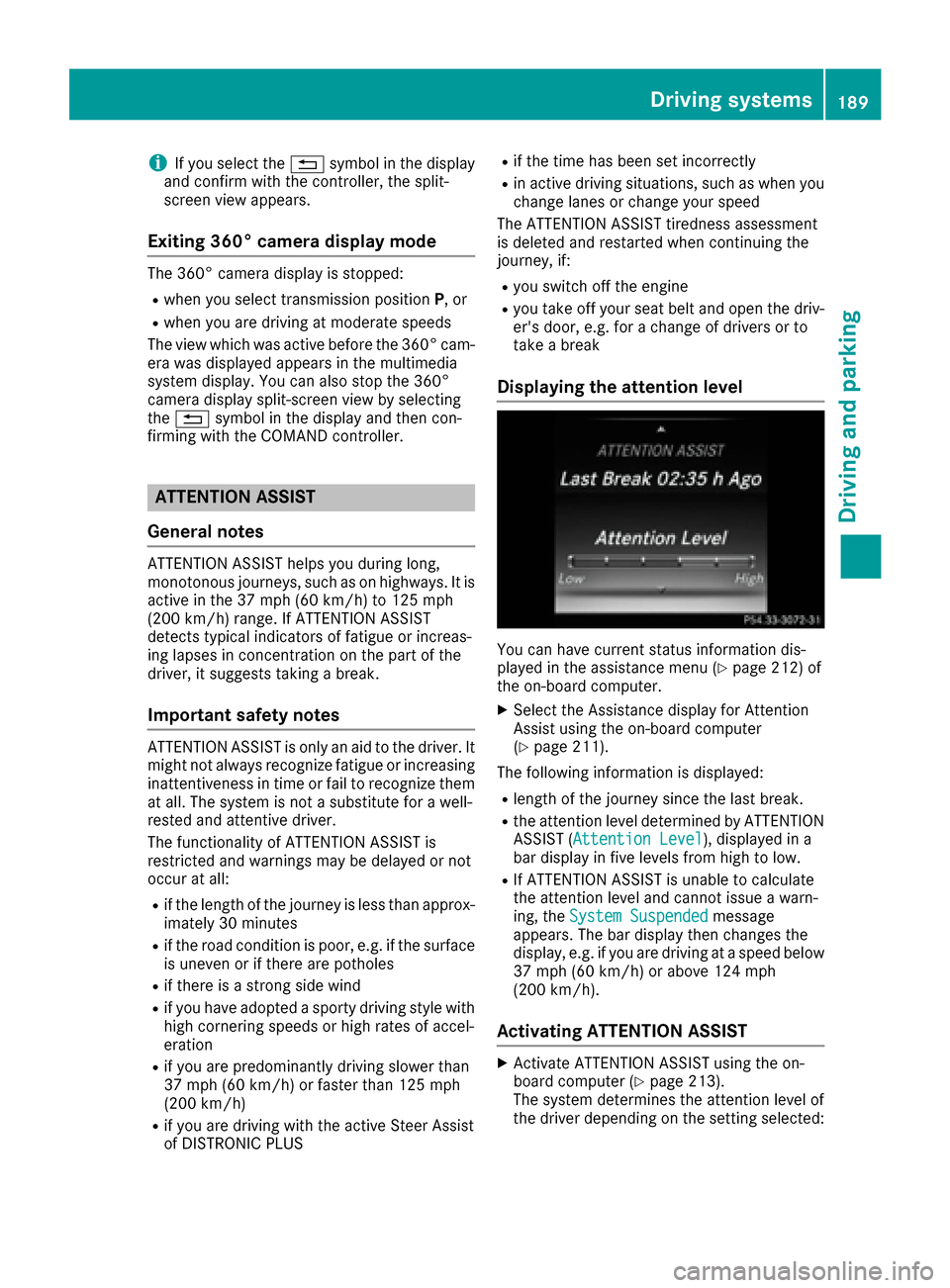
iIf you select the%symbo linthe display
and confirm with the controller, the split-
screen view appears.
Exitin g360° camera display mode
The 360° camera display is stopped:
Rwhen you select transmission position P,or
Rwhen you are driving at moderate speeds
The view which was active before the 360° cam- era was displaye dappears in the multimedia
system display. You can also stop the 360°
camera display split-screen view by selecting
the % symbo linthe display and then con-
firming with the COMAND controller.
ATTENTION ASSIST
General notes
ATTENTION ASSISTh elps you during long,
monotonous journeys, such as on highways .Itis
active in the 37 mph (60 km/h) to 125 mph
(200 km/h) range. If ATTENTION ASSIST
detects typica lindicators of fatigu eorincreas-
ing lapses in concentration on the part of the
driver, it suggests taking abreak.
Important safety notes
ATTENTION ASSISTiso nly an aid to the driver. It
might not always recognize fatigu eorincreasing
inattentiveness in time or fail to recognize them
at all .The system is not asubstitute for awell-
rested and attentive driver.
The functionality of ATTENTION ASSISTi s
restricted and warnings may be delayed or not
occur at all:
Rif the length of the journey is less than approx-
imatel y30m inutes
Rif the road condition is poor, e.g. if the surface
is uneven or if there are potholes
Rif there is astrong side wind
Rif you have adopted asporty driving style with
high cornering speedsorh igh rates of accel-
eration
Rif you are predominantly driving slower than
37 mph (60 km/h) or faster than 125 mph
(200 km/h)
Rif you are driving with the active Steer Assist
of DISTRONIC PLUS
Rif the time has been set incorrectly
Rin active driving situations, such as when you
change lanes or change you rspeed
The ATTENTION ASSISTt iredness assessment
is deleted and restarted when continuing the
journey, if:
Ryou switch off the engine
Ryou take off you rseat belt and open the driv-
er's door, e.g. for achange of drivers or to
take abreak
Displaying the attention level
You can have current status information dis-
played in the assistance menu (Ypage 212) of
the on-board computer.
XSelect the Assistance display for Attention
Assist using the on-board computer
(
Ypage 211).
The following information is displayed:
Rlength of the journey since the last break.
Rthe attention level determined by ATTENTION ASSIST( Attention Level), displaye dina
bar display in five levelsf rom high to low.
RIf ATTENTION ASSISTisu nabletoc alculate
the attention level and cannot issueaw arn-
ing, the System Suspended
message
appears. The bar display then changes the
display, e.g. if you are driving at aspeed below
37 mph (60 km/h) or above 124 mph
(200 km/h).
Activating ATTENTION ASSIST
XActivate ATTENTION ASSISTu sing the on-
board computer (Ypage 213).
The system determines the attention level of
the driver depending on the setting selected:
Driving systems189
Driving and parking
Z
Page 192 of 354
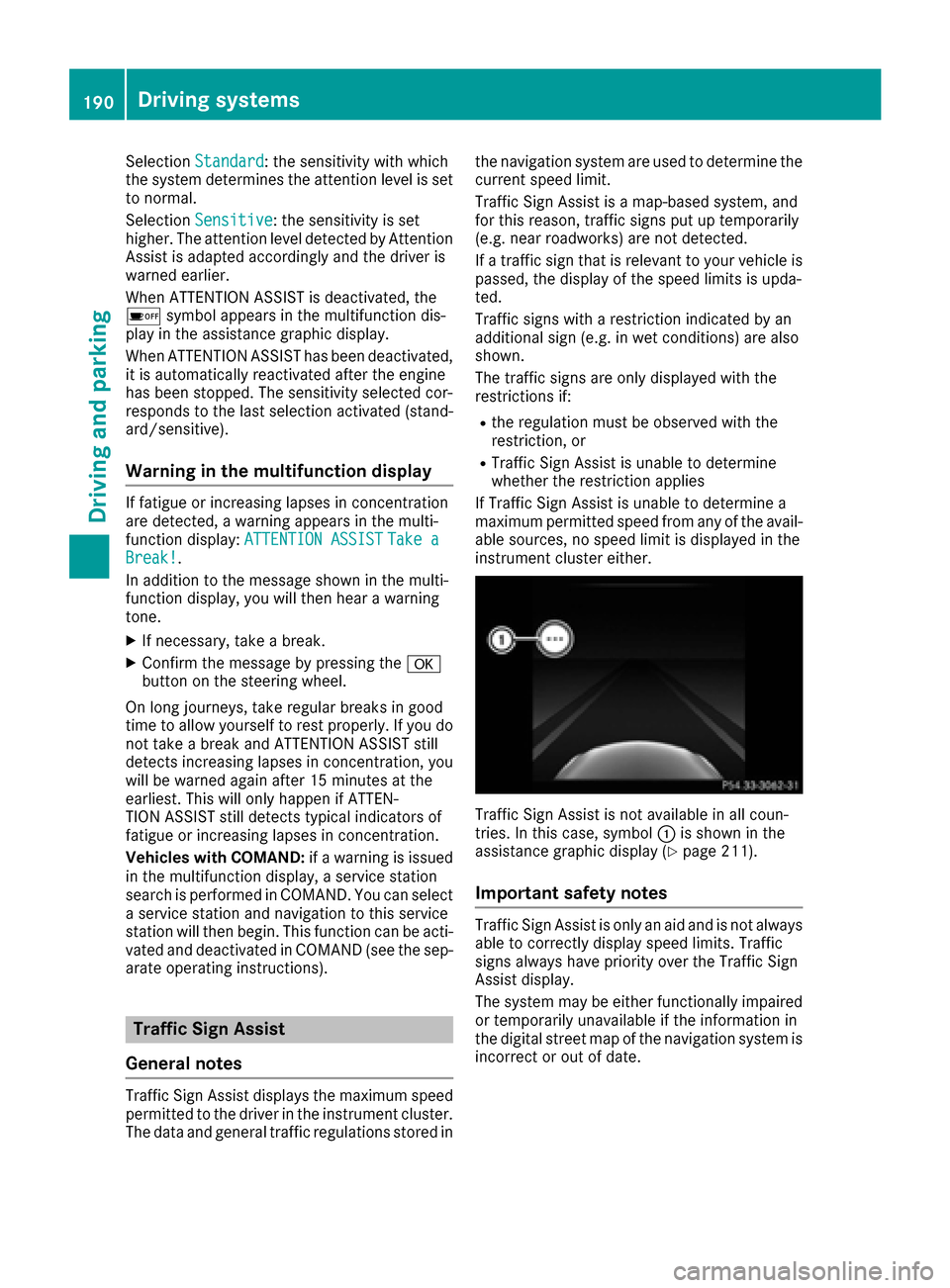
SelectionStandard:the sensitivity with which
the system determine sthe attention level is set
to normal.
Selection Sensitive
:the sensitivity is set
higher .The attention level detected by Attention
Assist is adapted accordingly and the driver is
warned earlier.
Whe nATTENTION ASSIST is deactivated, the
é symbo lapp ears in the multifunction dis-
play in the assistance graphi cdisplay.
Whe nATTENTION ASSIST hasb eend eactivated,
it is automaticall yreactivated afte rthe engine
hasb eens topped .The sensitivity selected cor-
respond stothe last selectio nactivate d(stand-
ard/sensitive).
Warning in the multifunctiond isplay
If fatigueorincreasing lapse sinconcentration
are detected, awarning appears in the multi-
function display: ATTENTIONASSIST
Take aBreak!.
In addition to the message shown in the multi-
function display ,you will then hea rawarning
tone.
XIf necessary, take abreak.
XConfirm the message by pressing the a
button on the steering wheel.
On long journeys, take regular breaks in good
time to allo wyourselftor est properly .Ifyoudo
not take abreak and ATTENTION ASSIST still
detects increasing lapse sinconcentration, you
will be warned agai nafter1 5m inutes at the
earliest. Thi swillo nly happe nifATTEN-
TION ASSIST stil ldetects typica lindicators of
fatigueori ncreasing lapse sinconcentration.
Vehicles with COMAND: ifaw arning is issued
in the multifunction display ,aservice station
search is performedinC OMAND. You can select
as ervice station and navigation to this service
station will then begin. Thi sfunction can be acti-
vate dand deactivated in COMAND (se ethe sep-
arate operating instructions).
Traffic Sig nAssis t
General notes
Traffic Sig nAssist display sthe maximum speed
permitte dtothe driver in the instrument cluster.
The data and general traffic regulations storedi nthe navigation system are used to determine the
current speed limit.
Traffic Sig
nAssist is amap-based system, and
for this reason, traffic signs pu tupt emporarily
(e.g. nearr oadworks) are not detected.
If at raffic sig nthat is relevant to your vehicl eis
passed, the display of the speed limits is upda-
ted.
Traffic signs with arestriction indicated by an
additiona lsign( e.g. in we tconditions )are also
shown.
The traffic signs are only displayed with the
restrictions if:
Rthe regulation mus tbeo bserve dwitht he
restriction, or
RTraffic Sig nAssist is unabl etodetermine
whethe rthe restriction applies
If Traffic Sig nAssist is unabl etodetermine a
maximum permitte dspeed from any of the avail-
able sources ,nospeed limit is displayed in the
instrument cluster either.
Traffic Sig nAssist is not available in al lcoun-
tries. In this case, symbol :is shown in the
assistance graphi cdisplay (
Ypage 211).
Important safety notes
Traffic Sig nAssist is only an ai dand is not always
able to correctly display speed limits .Traffic
signs always have priority ove rthe Traffic Sign
Assist display.
The system may be either functionall yimpaired
or temporaril yunavailabl eifthe information in
the digital stree tmap of the navigation system is
incorrect or outofd ate.
190Drivingsystems
Driving and parking
Page 193 of 354

Instrumentcluster display
Displaying th eassistance graphic
XCall up th eassistanc egraphic sdisplay func-
tion usin gthe on-board computer
(
Ypage 211).
XSelec tthe Traffic Sig nAssist display.
Detected traffic sign sare displayed in th e
instrumen tcluster.
Speed limit with unknown restriction
:Maximum permitte dspee d
;Maximum permitte dspee dfor vehicles for
whic hthe restriction in th eadditional sign is
relevan t
=Additional sign for unknown restriction
Am aximum permitte dspee dof80m ph
(80 km/h) and aspee dlimi tof60k m/h
(60 mph )withanu nknown restriction apply.
iThe unit for th espee dlimi t(km/h or mph )
depend sonthecountry in whic hyou are driv -
ing .Itisg enerally neither shown on th etraffic
sign no rontheinstrumen tcluste rbut must be
taken int oaccoun twhen observing th emax-
imum permitte dspeed.
Lane Tracking package
General notes
The Lan eTrackin gpackag econsists of Blind
Spot Assist (Ypage 191) and Lan eKeepin g
Assist (Ypage 193).
Blind Spot Assist
Generaln otes
Blind Spot Assist monitors th eareas on either
side of th evehicl ethata re no tvisible to th e
driver wit htwo lateral ,rear-facin gradar sen -
sors. Awarning display in th eexter iorm irror s
draws your attention to vehicles detecte dinthe
monitore darea. If you then switch on th ecor-
respondin gturns ignal to chang elane, you will
also receiv eanoptical and audible warning .
Blind Spot Assist support syou from aspee dof
approximately 20 mph (30 km/h).
Import ant safety notes
GWARNIN G
Blind Spot Assist does no treac tto:
Rvehicles overtake ntoo closely on th eside ,
placing them in th eblinds pota rea
Rvehicles whic happroac hwithal argespee d
differential and overtake your vehicl e
As aresult ,Blind Spot Assist may no tgive
warning sinsuchs ituations. Ther eisarisko f
an accident.
Always observ ethe traffic condition scare-
fully, and maintai nasafel ateral distance.
Blind Spot Assist is only an aid. It may fail to
detec tsom evehicles and is no substitut efor
attentive driving .Always ensur ethatthe re is
sufficien tdistanc etotheside for other road
user sand obstacles.
iUS Ao nly:
This device has been approve dbytheFCC as
a" Vehicular Radar System". The radar sensor
is intended for use in an automotive radar
system only. Removing, tampering with, or
altering th edevice will voi dany warranties,
and is no tpermitte dbytheFCC. Do no ttam -
per with, alter, or use in any non-approve d
way.
An yu nauthorized modification to this device
could voi dthe user’s authority to operate th e
equipment.
Ra dars ensors
The radar sensor sfor Blind Spot Assist are inte-
grated int othe rear bumper. Mak esuret hatthe
bumpers are free from dirt ,ice or slush. The
sensor smust no tbecovered, for exampl eby
Driving systems191
Driving and parking
Z
Page 194 of 354
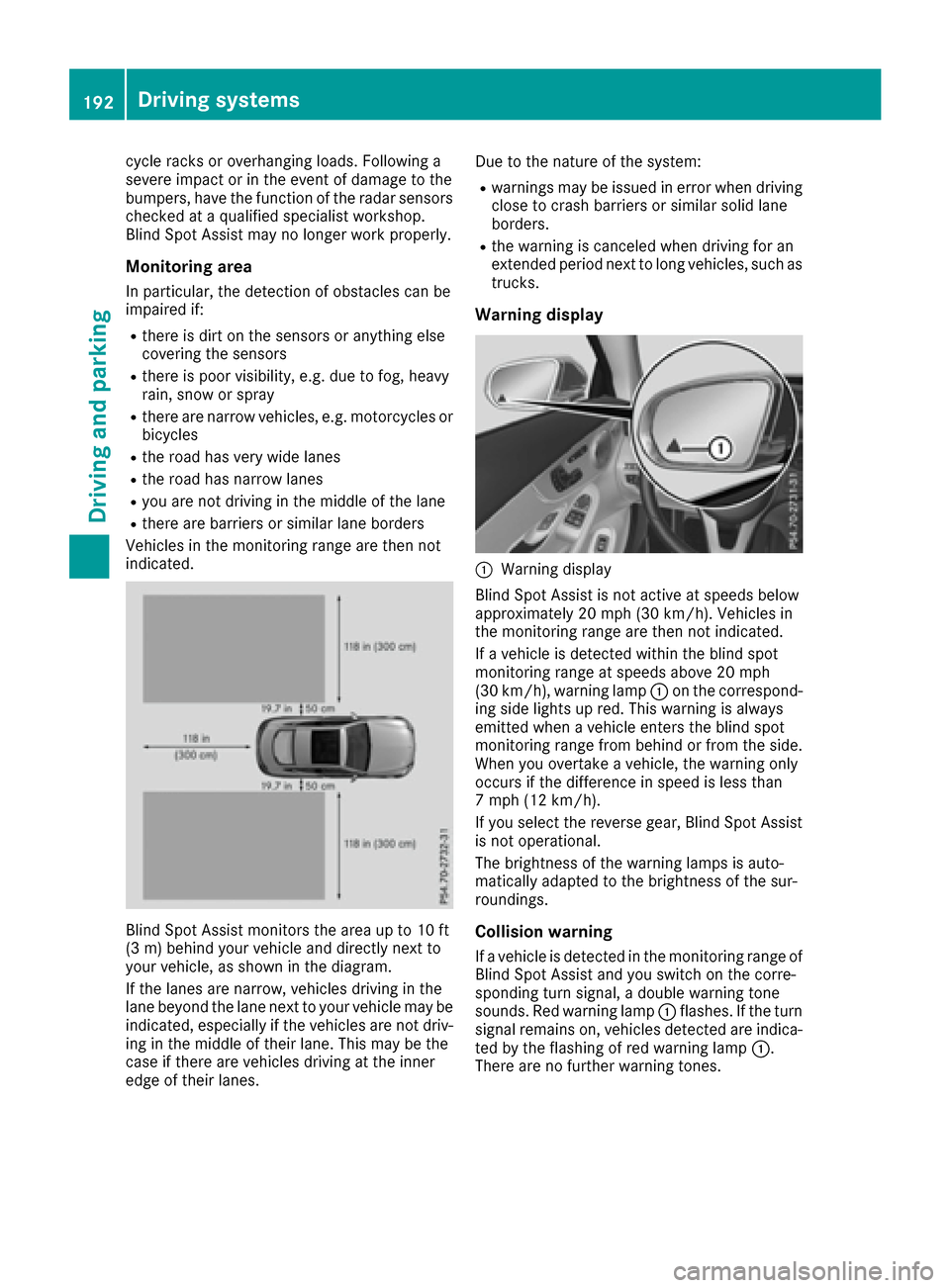
cycleracks or overhanging loads. Following a
severe impact or in the event of damag etothe
bumpers, have the function of the radar sensors
checke dataq ualified specialist workshop.
Blind Spot Assist may no longer work properly.
Monitoring area
In particular, the detection of obstacles can be
impaired if:
Rthere is dirt on the sensors or anything else
covering the sensors
Rthere is poo rvisibility,e .g. duetof og, heavy
rain, snow or spray
Rthere are narro wvehicles, e.g. motorcycle sor
bicycles
Rthe roadh asvery wide lanes
Rthe roadh asnarro wlanes
Ryoua re not driving in the middleoft he lane
Rthere are barriers or similar lane borders
Vehicles in the monitoring rang eare then not
indicated.
Blind Spot Assist monitors the are aupto10ft
(3 m) behind your vehicle and directl ynext to
your vehicle ,asshown in the diagram.
If the lanes are narrow, vehicle sdriving in the
lane beyond the lane next to your vehicle may be
indicated ,especially if the vehicle sare not driv-
ing in the middleoft heirlan e. Thism ay be the
case if there are vehicle sdriving at the inner
edg eoft heirlan es. Due to the nature of the system:
Rwarnings may be issue
dinerrorw hend riving
clos etoc rashb arriers or similar solid lane
borders.
Rthe warning is cancele dwhend riving for an
extended period next to long vehicles, such as
trucks.
Warning display
:Warning display
Blind Spot Assist is not active at speeds below
approximately 20 mph (30 km/h). Vehicles in
the monitoring rang eare then not indicated.
If av ehicle is detected within the blind spot
monitoring rang eatspeeds above 20 mph
(30 km/h), warning lamp :on the correspond-
ing sid elights up red .Thisw arning is always
emitted whe navehicle enters the blind spot
monitoring rang efrom behind or from the side.
Whe nyou overtake avehicle ,the warning only
occurs if the difference in speed is less than
7m ph (12 km/h).
If yo uselect the reverse gear, Blind Spot Assist
is not operational.
The brightnes softhe warning lamps is auto-
matically adapted to the brightnes softhe sur-
roundings.
Collision warning
If av ehicle is detected in the monitoring rang eof
Blind Spot Assist and yo uswitch on the corre-
sponding turn signal ,adoublew arning tone
sounds. Re dwarning lamp :flashes. If the turn
signal remains on, vehicle sdetected are indica-
ted by the flashing of red warning lamp :.
There are no further warning tones.
192Drivin gsystems
Drivin gand parking
Page 195 of 354

Switching on Blind Spot Assist
XMake sure that Blind Spot Assist
(Ypage 213) is activated in the on-board
computer.
XTurn the SmartKey to position 2in the ignition
lock.
Warning lamps :in the exterior mirrors light
up red until the engine is started.
Display in the assistance graphic
When Blind Spot Assist is activated, gray radar
waves propagating backwards appear next to
the vehicle in the assistance display in the mul-
tifunction display.A boveaspeed of 20 mph
(30 km/h), the color of the radar waves in the
assistance display changes to green :.Blind
Spot Assist is then ready for use.
Lane Keeping Assist
General notes
Lane Keeping Assist monitor sthe area in front of
your vehicle by means of multifunction cam-
era :which is attached behind the top of the
windshield. Active Lane Keeping Assist detects
lane markings on the road and can warn you
before you leave your lane unintentionally. This function is available in the range between
40 mph and 120 mph (60 km/h and 200 km/h).
Aw
arning may be given if afront wheel passes
over alane marking. It will warn you by means of
intermittent vibration in the steering wheel for
up to 1.5 seconds.
Important safety notes
GWARNING
Lane Keeping Assist may not always clearly
recognizel ane markings.
In this case, Lane Keeping Assist may:
Rgive an unnecessary warning
Rnot give awarning
There is arisk of an accident.
Always pay particular attention to the traffic
situation and stay in lane, in particular if
warned by Lane Keeping Assist.
GWARNING
The Lane Keeping Assist warning does not
return the vehicle to the original lane. There is
ar isk of an accident.
You should always steer, brake or accelerate
yourself, in particular if warned by Lane Keep-
ing Assist.
If you fail to adapt your driving style, Lane Keep-
ing Assist can neither reduce the risk of an acci-
dent nor override the laws of physics. Lane
Keeping Assist cannot take into account the
road, traffic and weather conditions. Lane Keep- ing Assist is merely an aid. You are responsible
for the distance to the vehicle in front,f or vehi-
cle speed, for braking in good time and for stay-
ing in your lane.
The Lane Keeping Assist does not keep the vehi-
cle in the lane.
The system may be impaired or may not function
if:
Rthere is poor visibility, e.g. due to insufficient
illumination of the road, or due to snow, rain,
fog or spray
Rthere is glare, e.g. from oncomingt raffic, the
sun or reflection s(e.g. when the road surface
is wet)
Rthe windshield is dirty, fogged up, damaged or
covered, for instancebyas ticker, in the vicin-
ity of the camera
Driving systems193
Driving and parking
Z
Page 196 of 354

Rthere areno, several or unclear lane markings
for alan e, e.g .inareas with roa dconstruction
work
Rthe lane markings ar eworna way, dark or cov-
ere dup,e.g .byd irtors now
Rthe distance to the vehicl einfront is too small
and the lane markings thusc annot be detec-
ted
Rthe lane markings change quickly, e.g .lan es
branch off ,cros sone anotherorm erge
Rthe roadisnarrow and winding
Rthere ar estrong shadows cas tonthe road
Activating/deactivating Lan eKeeping
Assist
XTo activate: press button ;.
Indicato rlam p: lights up .The Lan eKeep‐
ingAssistOnmessage appear sinthe mul-
tifunctio ndisplay .Ifallconditions have been
satisfied, there maybeaw arning.
If yo udrive at speeds above 40 mph
(60 km/h )and lane markings ar edetected,
the lines in the assistance graphics display
(
Ypage 211) ar eshown in green. Lane Keep-
ing Assist is ready for use.
XTo deactivate: press button;.
Indicato rlam p: goes out. Lane Keeping
Assist is deactivated .The Lan eKeeping
Assist Offmessage appear sinthe multi-
functio ndisplay .
Selecting Standard or Adaptiv esetting
XIn the DriveAssistmenu on the on-board
computer, select the LaneKeepingAssistfunction(Ypage 213).
XSelectStandardorAdaptive.
Standard
When Standard
is selected ,nowarning vibra-
tio no ccurs if:
Ryous witch on the tur nsignals .Int hise vent,
the warnings ar esuppr essedf orac ertain
perio doft ime.
Radrivin gsafety systemi ntervenes,suc ha s
ABS, BAS or ESP®.
Adaptive
When Adaptive
is selected ,nowarning vibra-
tio no ccurs if:
Ryous witch on the tur nsignals .Int hise vent,
the warnings ar esuppr essedf orac ertain
perio doft ime.
Radrivin gsafety systemi ntervenes,e.g.A BS,
BAS or ESP®.
Ryo ua ccelerate hard, e.g .kickdown.
Ryoub rake hard.
Ryous teer actively, e.g .swe rvetoa voidan
obstacle or change lanes quickly.
Ryo uc ut the corne ronasharp bend.
In order thaty ouarew arned onl ywhenn eces-
sary and in good tim eifyoucros sthe lane mark-
ing ,the systemr ecognizescertai nconditions
and warns yo uaccordingly.
The warning vibratio noccurs earlier if:
Ryoua pproach the outer lane marking on a
bend.
Rthe roa dhasver yw idel an es,e .g.ah ighway.
Rthe systemr ecognizessolid lane markings.
The warning vibratio noccurs later if:
Rthe roa dhasnarrow lanes.
Ryouc ut the corne ronabend.
Driving Assistance PLUS package
General notes
The Drivin gAssistance PLU Spackag econsists
of DISTRONI CPLUS(Ypage 162), Activ eBlind
Spo tAssist (Ypage 194 )and Active Lane Keep-
ing Assist (Ypage 197).
Active Blind SpotA ssist
General notes
Active Blind Spo tAssist uses aradar sensor
system ,pointe dtoward the rea rofthe vehicle,
to monitor the are atothe side softhe vehicle
which the driver is unabl etosee.Aw arning dis-
play in the exterio rmirrors draws your attention
to vehicles detectedint he monitoredarea. If
194Driving systems
Driving an dparking
Page 197 of 354
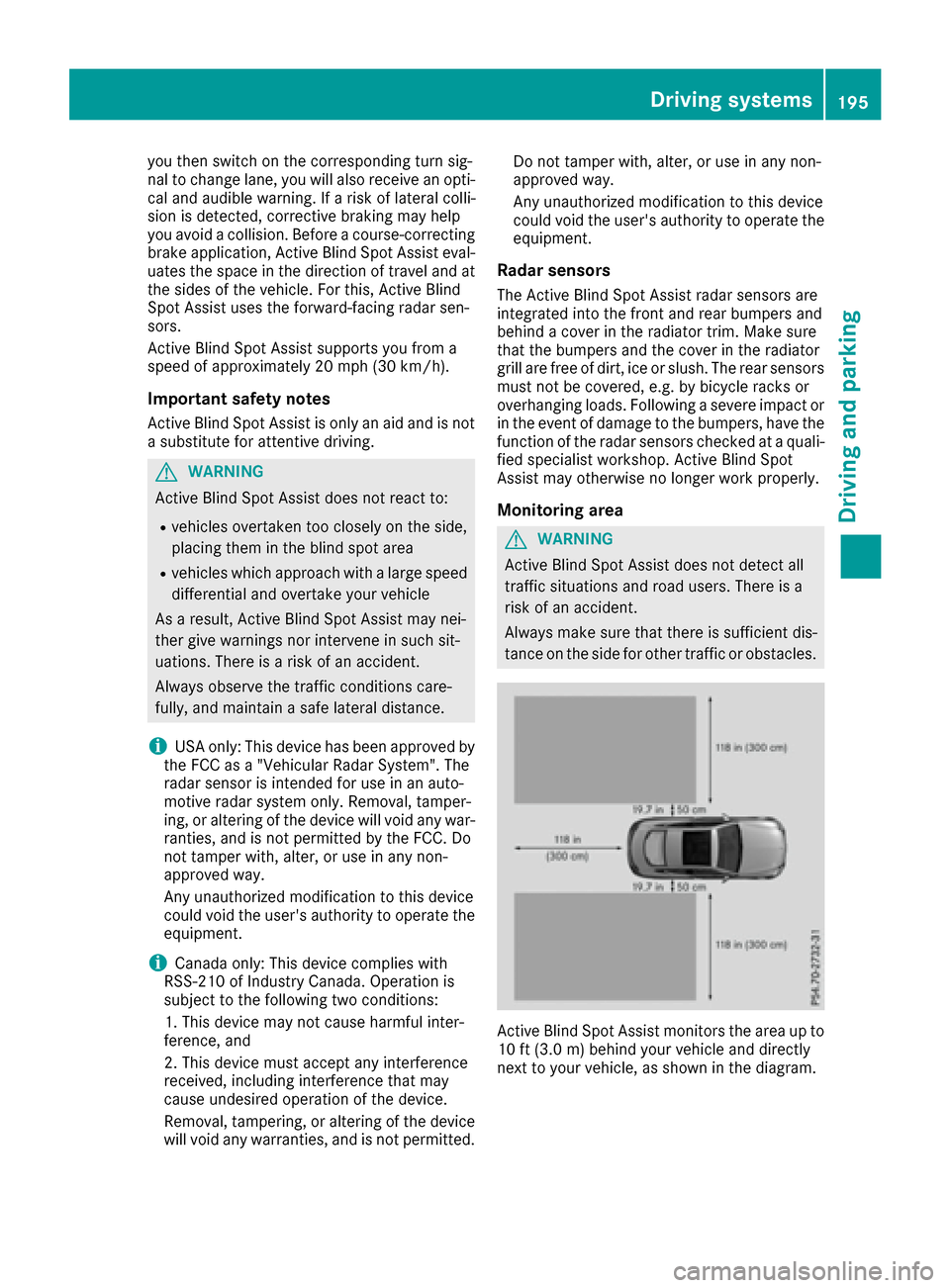
you then switch on thecorre spondin gturns ig-
nal to chang elane, you will also receiv eanopti-
cal and audibl ewarning. If ariskofl ateral colli-
sion is detected, corrective brakin gmay help
you avoid acollision .Befor eac ourse-correcting
brak eapplication ,Activ eBlind Spot Assis teval -
uates th espac eint hedirection of travel and at
th es ide soft hevehicle. Fo rthis, Active Blind
Spot Assis tuses th eforward-facing rada rsen-
sors.
Active Blind Spot Assis tsupport syou from a
speed of approximately 20 mph (30 km/h).
Important safety notes
Active Blind Spot Assis tisonlyana id and is no t
as ubstitut efor attentive driving.
GWARNIN G
Active Blind Spot Assis tdoes no treac tto:
Rvehicles overtake ntoo closely on th eside ,
placin gthemint heblin dspota rea
Rvehicles whic happroac hwithal argespeed
differential and overtake your vehicl e
As aresult ,Activ eBlind Spot Assis tmay nei-
ther giv ewarnings no rintervene in suchsit-
uations. There is ariskofana ccident.
Always observ ethe traffic condition scare-
fully, and maintai nasafel ateral distance.
iUS Ao nly: This device has been approve dby
th eF CC as a"Vehicular Radar System". The
rada rsensor is intended for use in an auto-
motive rada rsystem only. Removal, tamper -
ing, or altering of th edevice will voi dany war-
ranties, and is no tpermitte dbytheFCC. Do
no ttamper with, alter, or use in any non-
approve dway.
An yu nauthorize dmodification to this device
could voi dthe user's authorit ytoo perate th e
equipment.
iCanada only: This device complies wit h
RSS-210 of Industry Canada. Operation is
subjec ttothefollowin gtwo conditions:
1. This device may no tcaus eharmful inter-
ference ,and
2. This device mus taccept any interferenc e
received, includin ginterfe rencethatm ay
caus eundesired operation of th edevice .
Removal, tam peri
ng, or altering of th
edevice
will voi dany warranties, and is no tpermitted. Do no
ttamper with, alter, or use in any non-
approve dway.
An yu nauthorize dmodification to this device
could voi dthe user's authorit ytoo perate th e
equipment.
Rada rsensor s
The Active Blind Spot Assis trada rsensor sare
integrate dintot he fron tand rear bumpers and
behind acover in th eradiato rtrim. Mak esure
that th ebumpers and th ecover in th eradiato r
grill are free of dirt, ice or slush. The rear sensor s
mus tnotbe covered, e.g. by bicycle racks or
overhangin gloads .Following asevere impact or
in th eevent of damage to th ebumpers ,havet he
function of th erada rsensor schecked ataq uali-
fie ds pecialist workshop .Activ eBlind Spot
Assis tmay otherwise no longer wor kproperly.
Monitoring area
GWARNIN G
Active Blind Spot Assis tdoes no tdetec tall
traffic situation sand roa dusers. There is a
ris kofana ccident.
Always mak esuret hatthe re is sufficien tdis-
tance on th eside for other traffic or obstacles.
Active Blind Spot Assis tmonitors th earea up to
10 ft (3. 0m)behind your vehicl eand directl y
next to your vehicle, as shown in th ediagram.
Driving systems195
Driving and parking
Z
Page 198 of 354

The detection of obstacles can be impaired in
the case of:
Rthere is dirt on the sensors or anything else
coveringthe sensors
Rpoor visibility, e.g. due to rain, snow or spray
Vehicles in the monitoring range are then not
indicated.
Active Blind Spot Assist may not detect narrow
vehicles, such as motorcycles or bicycles, or
may only detect them too late.
If the lanes are narrow, vehicles driving in the
lane beyond the lane next to your vehicle may be
indicated, especially if the vehicles are not driv- ing in the middle of their lane. This may be the
case if there are vehicles at the inner edge of
your lane.
Due to the nature of the system:
Rwarnings may be issued in error when driving
close to crash barriers or similar solid lane
borders.
Rwarnings may be interrupted when driving
alongside particularly long vehicles, e.g.
trucks, for aprolonged time.
Warning display
:Warning display
Active Blind Spot Assist is not operational at
speeds below approximately 20 mph (30 km/h).
Vehicles in the monitoring range are then not
indicated.
If av ehicle is detected within the blind spot
monitoring range at speeds above 20 mph
(3 0k m/ h),w arnin glamp :on the correspond-
ing side lights up red. This warnin gisalways
emitted when avehicle enters the blind spot
monitoring range from behind or from the side.
When you overtake avehicle, the warnin gonly
occurs if the differenc einspeed is less than
7m ph (12 km/h). If you select the reverse gear, Active Blind Spot
Assis
tisnot operational.
The brightness of the warnin glamps is auto-
matically adapted to the brightness of the sur-
roundings.
When Active Blind Spot Assis tisactivated, gray
radar waves propagatin gbackwards appear
nex ttot he vehicle in the assistance display in
the multifunction display. Abov easpeed of
20 mph (30 km/h), the color of the radar waves
in the assistance display changes to green ;.
Active Blind Spot Assis tisthen ready for use.
Visua land acoustic collision warning
If you switc honthe turn signals to change lanes
and avehicle is detected in the side monitoring
range, you receiv eavisual and acoustic collision
warning. You will then hear adouble warning
ton eand red warnin glamp :flashes. If the turn
signal remainso n, detected vehicles are indica-
ted by the flashingofr ed warninglamp :.
There are no further warnin gtones.
Course-correcting brake application
If Active Blind Spot Assis tdetects arisk of alat-
eral collision in the monitoring range, acourse-
correcting brake application is carried out. This
is meant to assist you in avoiding acollision.
GWARNING
Ac ourse-correctin gbrake application cannot
always preventac ollision.There is arisk of an
accident.
Always steer ,brake or accelerate yourself,
especially if Active Blind Spot Assis twarns
you or makes acourse-correctin gbrake appli-
cation. Always maintain asafe distance at the
sides.
196Driving systems
Driving and parking
Page 199 of 354
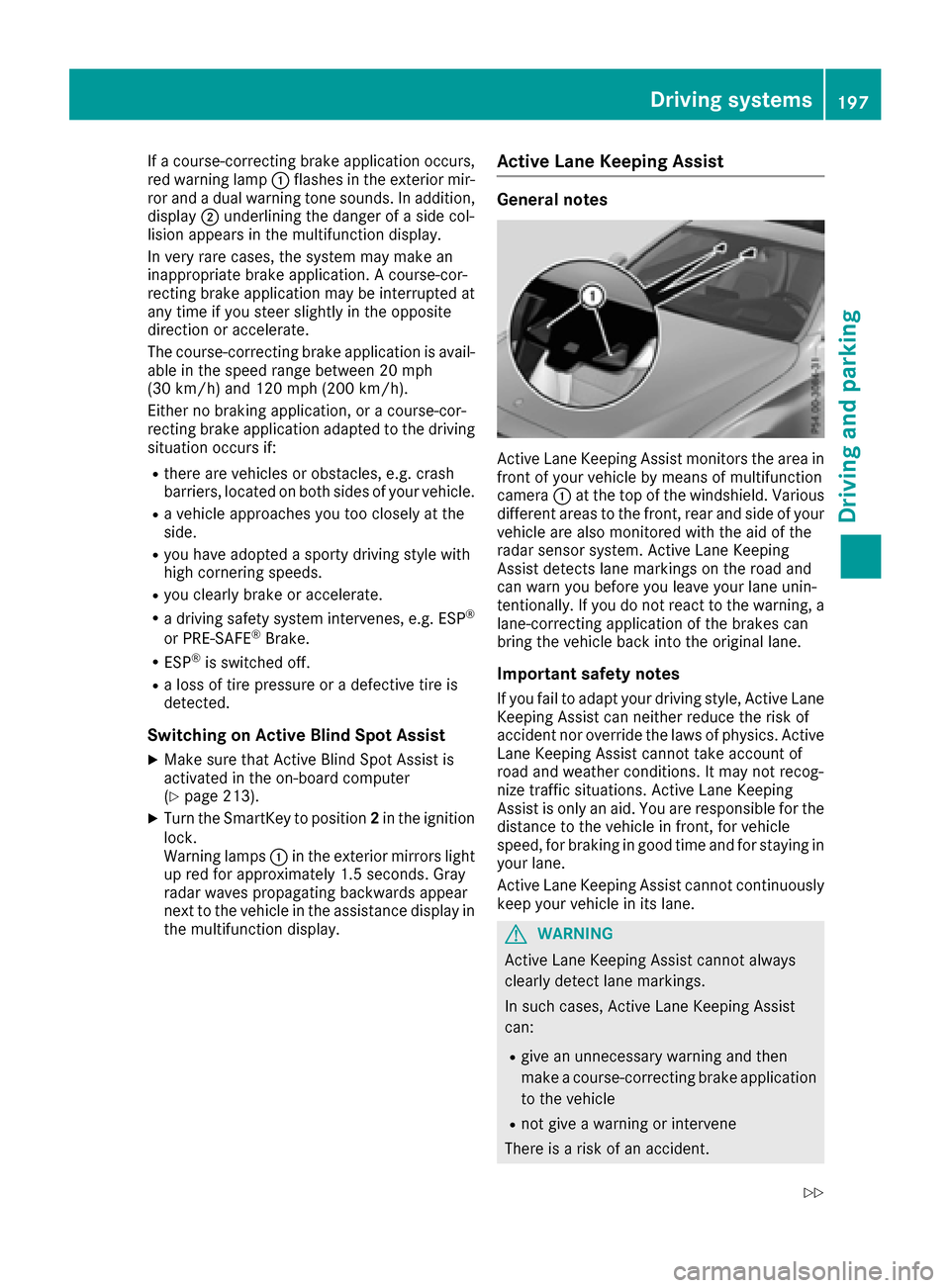
Ifac ourse-correcting brake application occurs,
red warning lamp :flashe sinthe exterior mir-
ror and adualw arning tone sounds. In addition,
display ;underlining the danger of aside col-
lision appears in the multifunction display.
In very rare cases, the system may make an
inappropriate brake application. Acourse-cor-
recting brake application may be interrupted at
any time if you steer slightly in the opposite
direction or accelerate.
The course-correcting brake application is avail-
abl eint he speed range between 20 mph
(30 km/h) and 120 mph (200 km/h).
Either no braking application, or acourse-cor-
recting brake application adapted to the driving
situation occurs if:
Rthere are vehiclesoro bstacles,e.g. crash
barriers, located on both sides of you rvehicle.
Rav ehicle approaches you too closely at the
side.
Ryou have adopted asporty driving style with
high cornering speeds.
Ryou clearl ybrake or accelerate.
Rad riving safety system intervenes, e.g. ESP®
or PRE-SAFE®Brake.
RESP®is switched off.
Raloss of tire pressure or adefective tire is
detected.
Switching on Activ eBlind Spot Assist
XMake sure that Active Blind Spot Assist is
activated in the on-board computer
(
Ypage 213).
XTurn the SmartKey to position 2in the ignition
lock.
Warning lamps :in the exterior mirrors light
up red for approximately 1.5 seconds .Gray
rada rwave spropagating backwards appear
next to the vehicle in the assistance display in
the multifunction display.
Active Lane Keeping Assist
General notes
Active Lane Keeping Assist monitors the area in
front of you rvehicle by means of multifunction
camera :at the top of the windshield. Various
different area stothe front, rear and side of your
vehicle are also monitored with the aid of the
rada rsensor system. Active Lane Keeping
Assist detects lane markings on the road and
can warn you before you leave you rlane unin-
tentionally .Ifyou do not react to the warning, a
lane-correcting application of the brakes can
bring the vehicle back into the originall ane.
Important safety notes
If you fail to adapt yourdriving style, Active Lane
Keeping Assist can neither reduce the risk of
accident nor override the law sofphysics. Active
Lane Keeping Assist cannot take account of
road and weather conditions. It may not recog-
nize traffic situations. Active Lane Keeping
Assist is only an aid .You are responsible for the
distance to the vehicle in front, for vehicle
speed,f or braking in good time and for staying in
you rlane.
Active Lane Keeping Assist cannot continuously
keep you rvehicle in its lane.
GWARNING
Active Lane Keeping Assist cannot always
clearl ydetect lane markings.
In such cases, Active Lane Keeping Assist
can:
Rgive an unnecessary warning and then
make acourse-correcting brake application
to the vehicle
Rnot give awarning or intervene
There is arisk of an accident.
Driving systems197
Driving and parking
Z
Page 200 of 354

Alwayspayparticula rattentio ntothe traffic
situatio nand kee pwithint he lane, especially
if Active Lane Keeping Assist alerts you. Ter-
minate the interventio ninanon-critica ldriv-
ing situation.
The system maybei mpaired or maynot function
if:
Rther eisp oorvisibility ,e.g.d ue to insufficient
illuminatio nofthe road, or du etosnow,rain,
fog or spray
Rther eisg lare,e.g.f rom oncoming traffic, the
sunorr eflections (e.g. when the roa dsurface
is wet)
Rthe windshield is dirty,f ogged up,damag ed or
covered ,for instance by asticker, in the vicin-
ity of the camera
Rthe rada rsensors in the front or rea rbum pers
or the radiato rtrim ar edirty,e .g.o bscured by
snow
Rther eareno, severa lorunclea rlan em arkings
for alan e, e.g .inareas with roa dconstruction
work
Rthe lane marking sareworn away ,darkorc ov-
ere dup,e.g .byd irtors now
Rthe distance to the vehicl einfront is too small
and the lane marking sthusc annotbed etec-
ted
Rthe lane marking schange quickly, e.g .lan es
branch off, cros sone another or merge
Rthe roa disnarrow and winding
Rtherearestrong shadows cas tonthe road
If no vehicl eisdetectedint he adjacent lane and
broken lane marking saredete
cted, no lane-cor-
recting brake applicatio nism ade.
Warning vibration in the steering wheel
Aw arning maybeg iven if afront whee lpasses
ove ralanem arking .Itw illw arny ou by means of
intermittent vibratio ninthe steering whee lfor
up to 1.5 seconds.
Lane -correcting brake application
If you leave you rlane, unde rcertai ncircumstan-
ces the vehicle will brake briefly on one side.
Thisism eant to assist you in bringing the vehicle
back to the original lane.
GWARNING
Al ane-correcting brake application cannot
always bring the vehicle back into the original lane. Thereisar isk of an accident.
Always steer, brake or accelerate yourself,
especially if Active Lane Keeping Assis twarns
you or makes alane-correcting brake appli-
cation.
If al ane-correcting brake application occurs,
display :appear sinthe multifunction display.
The brake application also slightly reduces vehi-
cle speed.
Thisf unctio nisavailable in the range between
40 mph and 120 mph (60 km/h and 200 km/h).
Al ane-correcting brake application can be made
after driving over alanem arking detected as
being solid or broken. Before this, awarning
must be give nbym eans of intermittent vibration
in the steering wheel. In addition, alanew ith
lane markings on both sides must be recog-
nized.
In the case of abroken lane marking being
detected,al ane-correcting brake application
can only be mad eifavehicle has beend etected
in the adjacent lane. Oncoming vehicles ,over-
taking vehicles and vehicles in adjacent lanes
can be detected.
iAf urthe rlane-correcting brake application
can only occur after you rvehicle has returned
to the original lane.
No lane-correcting brake application occurs if:
Ryou clearly and actively steer, brake or accel- erate.
Ryou cut the corner on asharp bend.
Ryou have switched on the turn signal.
Rad riving safety system intervenes, e.g. ESP®,
PRE-SAFE®Brake or Active Blind Spot Assist.
198Driving systems
Drivin gand parking